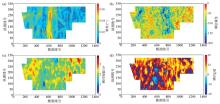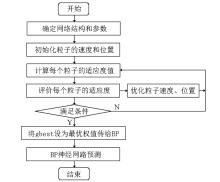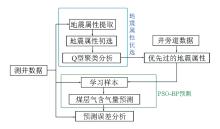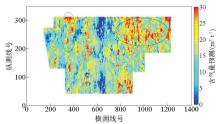|
|
|
| Prediction of coalbed methane content based on preferred seismic attributes and PSO-BP model |
ZANG Zi-Jing1, WU Hai-Bo1( ), DING Hai2, ZHANG Ping-Song1, DONG Shou-Hua3 ), DING Hai2, ZHANG Ping-Song1, DONG Shou-Hua3 |
1. School of Earth and Environment,Anhui University of Science and Technology,Huainan 232001,China
2. Laboratory of Unconventional Gas,Institute of Exploration,Anhui Coalfield Geology Bureau,Hefei 230088,China
3. School of Resources and Earth Sciences,China University of Mining and Technology,Xuzhou 221116,China |
|
|
|
|
Abstract Conventional coal seam gas content prediction methods are mostly based on logging constrained seismic attribute inversion and linear mapping model,which makes the prediction accuracy difficult to control,and severely limits the universality of the method.This paper starts with two aspects:seismic attribute optimization and BP neural network prediction model improvement.Using the Q-type clustering analysis method,the seismic attributes of the extracted target reservoirs are classified and optimized,and four kinds of seismic attributes with good correlation with the geological targets are obtained.The particle swarm optimization algorithm is further used to BP neural network algorithm.The connection weights of the input layer and the hidden layer and the threshold of the hidden layer are optimized,and the PSO-BP prediction model is constructed.The PSO-BP model is trained by using the preferred seismic attributes and gas content data of the well location.Based on the trained PSO-BP model,the coal seam gas content prediction in the study area is carried out with the preferred seismic attributes of the entire work area as input.The comparison between the predicted gas content of the well position and the measured results shows that the prediction method has high accuracy.Therefore,it can be considered that the PSO-BP prediction model and the corresponding prediction method flow can be effectively applied to the prediction of coal gas content in coal reservoirs.
|
|
Received: 25 November 2019
Published: 29 December 2020
|
|
|
|
Corresponding Authors:
WU Hai-Bo
E-mail: wuhaibocumt@163.com
|
|
|
|

|
Overview of study area
|

|
Typical seismic profile after process
|

| 地震属性 | 声阻抗 | 最大曲率 | 倾角属性 | 甜点属性 | 薄层属性 | 瞬时加速度 | 瞬时振幅 | 瞬时频率 | 瞬时Q值 | | 属性编号 | 1 | 2 | 3 | 4 | 5 | 6 | 7 | 8 | 9 | | 煤层含气量 | -0.0154 | -0.1314 | -0.2406 | 0.0154 | -0.3609 | -0.2636 | 0.1212 | 0.0548 | -0.1073 |
|
Correlation coefficient between each property of well location and gas content of coal seam
|

|
Seismic attribute clustering analysis
|

|
Preferred seismic attribute map
a—dip;b—thin bed;c—instanteous amplitude;d—instanteous Q
|

|
BP neural network structure
|

|
Particle swarm improvement BP neural network flow chart
|

|
Forecast model flow chart
|

|
Target coal reservoir gas content prediction results map
|

| 井号 | 实测值/(m3·t-1) | 预测值/(m3·t-1) | 误差率/% | | Q1201 | 18.9 | 18.904 | 0.02 | | Q1202 | 7.97 | 8.041 | 0.89 | | Q1203 | 13.39 | 13.453 | 0.47 | | Q1204 | 25.50 | 25.502 | 0.01 | | Q1205 | 5.39 | 5.4110 | 0.39 | | Q1206 | 10.27 | 10.230 | 0.39 | | Q1208 | 12.66 | 12.728 | 0.54 | | Q1501 | 15.45 | 15.504 | 0.35 | | Q1502 | 25.7 | 25.657 | 0.17 | | Q1503 | 18.8 | 18.825 | 0.13 |
|
Comparison of predicted and measured values of well locations
|
| [1] |
邵林海. 基于三维地震资料的煤层气富集区预测[D]. 西安:西北大学, 2016.
|
| [1] |
Shao L H. The application of 3D seismic date for the CBM enrichment region predication[D]. Xi'an: Northwest University, 2016.
|
| [2] |
卜小平. 中国煤层气产业发展途径与前景分析[D]. 北京:中国地质大学(北京), 2011.
|
| [2] |
Bu X P. Analysis of development approaches and prospects of coalbed methane industry in China[D]. Beijing:China University of Geosciences (Beijing), 2011.
|
| [3] |
张勇昌. 煤层气开发风险形成机制与评价模型研究[D]. 徐州:中国矿业大学, 2017.
|
| [3] |
Zhang Y C. Study on risk formation mechanism and evaluation model of coalbed methane development[D]. Xuzhou:China University of Mining and Technology, 2017.
|
| [4] |
秦勇, 袁亮, 胡千庭, 等. 我国煤层气勘探与开发技术现状及发展方向[J]. 煤炭科学技术, 2012,40(10):1-6.
|
| [4] |
Qin Y, Yuan L, Hu Q T, et al. Status and development orientation of coal bed methane exploration and development technology in china[J]. Coal Science and Technology, 2012,40(10):1-6.
|
| [5] |
祁雪梅. 煤层气储层地震属性响应特征及应用[D]. 徐州:中国矿业大学, 2013.
|
| [5] |
Qi X M. Coalbed methane reservoir seismic response characteristics and applications[D]. Xuzhou:China University of Mining and Technology, 2013.
|
| [6] |
孟召平, 郭彦省, 张纪星. 基于测井参数的煤层含气量预测模型与应用[J]. 煤炭科学技术, 2014,42(6):25-30.
|
| [6] |
Meng Z P, Guo Y S, Zhang J X. Application and prediction model of coalbed methane content based on logging parameters[J]. Coal Science and Technology, 2014,42(6):25-30.
|
| [7] |
田敏. 煤层气资源量预测中的灰色系统理论研究[D]. 北京:中国石油大学, 2008.
|
| [7] |
Tian M. Study on the grey system theory in the prediction of coalbed methane resources[D]. Beijing:China University of Petroleum, 2008.
|
| [8] |
彭苏萍, 杜文凤, 殷裁云, 等. 高丰度煤层气富集区地球物理识别[J]. 煤炭学报, 2014,39(8):1398-1403.
|
| [8] |
Peng S P, Du W F, Yin C Y, et al. Geophysical identification of high abundance coalbed methane enrichment area[J]. Journal of Coal, 2014,39(8):1398-1403.
|
| [9] |
陈贵武, 董守华, 吴海波, 等. 高丰度煤层气富集区地球物理定量识别技术研究与应用[J]. 地球物理学进展, 2014,29(5):2151-2156.
|
| [9] |
Chen G W, Dong S H, Wu H B, et al. Research and application of quantitative geophysics recognition in high abundance of coalbed methane rich region[J]. Progress in Geophysics, 2014,29(5):2151-2156.
|
| [10] |
曹军涛, 赵军龙, 王轶平, 等. 煤层气含量影响因素及预测方法[J]. 西安石油大学学报:自然科学版, 2013,28(4):28-34.
|
| [10] |
Chao J T, Zhao J L, Wang Y P, et al. Factors affecting coalbed methane content and prediction methods[J]. Journal of Xi'an Shiyou University:Natural Science Edition, 2013,28(4):28-34.
|
| [11] |
祁雪梅, 董守华. 地震相技术在煤层气勘探中的应用[J]. 物探与化探, 2012,36(2):170-173.
|
| [11] |
Qi X M, Dong S H. Application of seismic facies technology in coalbed methane exploration[J]. Geophysical and Geochemical Exploration, 2012,36(2):170-173.
|
| [12] |
张瑞, 陈刚, 潘保芝, 等. 基于细菌觅食优化广义回归神经网络的煤层气含量预测[J]. 物探与化探, 2016,40(2):327-332.
|
| [12] |
Zhang R, Chen G, Pan B Z, et al. Prediction of coalbed methane content based on generalized regression neural network optimized by bacterial foraging[J]. Geophysical and Geochemical Exploration, 2016,40(2):327-332.
|
| [13] |
李刚. 基于BP算法的煤层厚度预测技术应用研究[J]. 中国煤炭地质, 2011,23(5):45-48.
|
| [13] |
Li G. An applied research on coal thickness prediction technology based on BP algorithm[J]. Coal Geology of China, 2011,23(5):45-48.
|
| [14] |
梅洋洋, 秦云强. 基于BP神经网络的煤层气井产水量预测研究[J]. 煤炭技术, 2018,37(12):163-165.
|
| [14] |
Mei Y Y, Qin Y Q. Study on water production of coalbed methane well by using BP neural network[J]. Coal Technology, 2018,37(12):163-165.
|
| [15] |
胡胜利, 钱旭, 钟峰. 基于遗传算法和人工神经网络的煤层厚度预测[J]. 中国煤炭, 2010,36(2):69-71,76.
|
| [15] |
Hu S L, Qian X, Zhong F. Genetic algorithm and artificial neural network based coal seam thickness forecasting[J]. Coal of China, 2010,36(2):69-71,76.
|
| [16] |
张丽平. 粒子群优化算法的理论及实践[D]. 杭州:浙江大学, 2005.
|
| [16] |
Zhang L P. The theorem and practice upon the particle swarm optimization algorithm[D]. Hangzhou:Zhejiang University, 2005.
|
| [17] |
马秋芳. 改进PSO优化的BP神经网络短时交通流预测[J]. 计算机仿真, 2019,36(4):94-98.
|
| [17] |
Ma Q F. BP neural network short-term traffic flow prediction based on improved particle swarm optimization[J]. Computer Simulation, 2019,36(4):94-98.
|
| [18] |
徐开, 陈志刚, 赵靖华, 等. 基于粒子群算法的星敏感器布局设计[J]. 吉林大学学报:工学版, 2019,49(3):972-978.
|
| [18] |
Xu K, Chen Z G, Zhao J H, et al. Layout design method of star sensor based on particle swarm optimization algorithm[J]. Journal of Jilin University:Engineering and Technology Edition, 2019,49(3):972-978.
|
| [19] |
徐星, 李喆. 基于改进粒子群BP神经网络的矿井突水水源判别[J]. 煤炭技术, 2018,37(6):157-158.
|
| [19] |
Xu X, Li Z. Identification of mine water inrush source based on improved particle swarm optimization and BP neural network[J]. Coal Technology, 2018,37(6):157-158.
|
| [20] |
张德慧, 张德育, 刘清云, 等. 基于粒子群算法的BP神经网络优化技术[J]. 计算机工程与设计, 2015,36(5):1321-1326.
|
| [20] |
Zhang D H, Zhang D Y, Liu Q Y, et al. BP neural network optimized by improved PSO[J]. Computer Engineering and Deign, 2015,36(5):1321-1326.
|
| [21] |
Wu D M, Zhao Y M, Cheng Y P, et al. ΔP index with different gas compositions for instantaneous outburst prediction in coal mines[J]. Mining Science and Technology(China), 2010,20(5):723-726.
|
| [1] |
ZHU Yan, HAN Xiang-Yi, YUE Xin-Xin, YANG Chun-Feng, CHANG Wen-Xin, XING Li-Juan, LIAO Jing. Research and application of brittleness logging evaluation method to tight sandstone reservoirs:Exemplified by Weibei oilfield in Ordos Basin[J]. Geophysical and Geochemical Exploration, 2021, 45(5): 1239-1247. |
| [2] |
ZHANG Peng-Fei, ZHANG Shi-Hui. Neural network seismic prediction of sand and mudstone lithology of Pinghu Formation in Xihu Sag[J]. Geophysical and Geochemical Exploration, 2021, 45(4): 1014-1020. |
|
|
|
|

